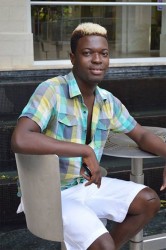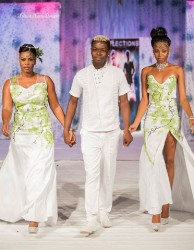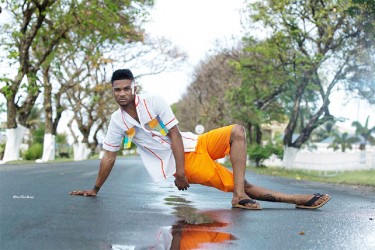Nelsion Nurse has won several awards for his designs of Mashramani costumes bands and props for his fashion designs as well. When The Scene caught up with the 27-year-old, he was working on a sketch as he gets set for this year’s celebrations. Meanwhile, in a cabinet across the room are dozens of framed awards and plaques.
In 2013 and 2014 he worked with the Ministry of Education winning the First Prize in the Small Band Category and Best Designer Award in the same category in the respective years. Nelsion has also designed for various beauty pageants over the past five years: Miss Amerindian Heritage, Miss Bartica Regatta, Mr and Ms Guyana Talented Teens.

The Scene: How did it all start for you?
Nelsion: I started sketching at the age of 13, but it was not until 2007 that I brought something to life. I started costume designing competitively and my first client was Head Start Nursery School with my friend Jermaine Brooms. Actually he was the designer at the time and I was more of the assistant but after that we collaborated and worked together on many projects, he was one of my closest friends and we designed for Mashramani every year except in 2008 and 2009. I was in the Dominican Republic then on a missionary trip for my church. I am a member of the Church of Jesus Christ of Latter Day Saints. During those two years in the Dominican Republic I had a first-hand look at their carnival and I was soon attending carnival camp lectures on costume making.
When I returned home to Guyana in 2010 Jermaine and I started working on the Carib beer costumes and a band called Blue Wave. In 2012, I started doing independent work and the first band I worked solo on was the APNU band called ‘ENVY’ meaning Energetic New Vibrant Youth. The ban was also dubbed ‘Green-Naval’ which won second place in the large band category.
The Scene: What are your intentions for this year’s Mashramani?
Nelsion: Well I am bidding to design for the Ministry of Education again. I like the ministry’s themes and relating them to my work… I am optimistic about winning the ministry’s bid and winning an award.
I am really looking forward to designing for a large band. I have grown a lot and I received a lot of experience and exposure. I have delivered quite well in the past and I think I can deliver well again.

The Scene: For years you have been an active member in the artistic developments during Mashramani, what do you think needs to be changed to improve the festival particularly on the day of the Float parade?
Nelsion: I am really hoping that they would bring back the Mash King and Queen competition in the night. [Those are] the two best costumes in the bands and they are judged separately based on the creativity and how well the King and Queen costumes complement each other and showcase the band’s message.
Mash during the day is the revelling and jump-up but at nights it was doing the extra and showing off. The focus was on the costumes for this King and Queen competition.
Concerning the route of the parade they [the organisers] need to do something about the judging point at Forshaw and Irving streets – it should be cleared or crowd managed because there is very little space for manoeuvring big floats there when everyone is congesting the corner. … There is not much exposing the energy and vibes of the band or the brilliance of the costumes to the judges. Some of the main pieces are huge but crammed in that small space it’s hard to manoeuvre considering children and adults in that space can be injured.
There is also the issue of preparing for Mash. Although it is launched since September/October most bands do not start bidding until mid-January which does not give adequate time for sourcing materials or getting costumes completed; even though I have never had this problem. You can see the result of this in some bands with rushed costumes that fall apart or look skimpy. Maybe that is why you see some costumes of those standards out there.
They say Mash is our thing but I think some bands need to stop with the t-shirts and rice bags or straw skirts, it makes Mash look cheap. There is no issue with recycling and reusing but designers can be more creative. Designer Carol Fraser is known for using recycled materials and being creative with them.

The Scene: Can you comment on the state of arts in Guyana?
Nelsion: The arts in Guyana are dying because of the lack of support and it is not just from society. Every country has culture yes and lots of [administrative] divisions in the arts but here they are not in it for the business and cultural aspects but a dog-eat-dog system. Every arena has rivalry but here it is not to build each other through fair competition but rather to pull you down in order to get up.
The Scene: You are also a fashion designer…
Nelsion: My first year doing fashion was in 2010 at Guyana Fashion Weekend, specifically the Designer Portfolio and Model Search. I attended the finale ‘Glamour’ and was intrigued by the pieces, I later met Sonia [Noel] and she was kind enough to invite me to audition and I presented two finished pieces and a sketch of my designs.
My first collection was called Patches. I use clothes to tell stories and Patches talked about the phases of life. Using black and white to symbolise strength and wisdom, the good and bad and need to overcome those patches in life.
From then on I became an outgoing person. Costume designing is always backstage and I never really liked the spotlight but in the fashion work you have to be there with your models and audience. That year I received the Special Prize for Most Promising Designer.
The Scene: Does designing excite you? How does it make you feel?
Nelsion: Every time I design something, I give a piece of me. It is all about expressing myself through my thoughts; it is letting my mind soar and I allow myself to be free – I do not limit myself. Creativity does not have boundaries.
The Scene: Where do you see yourself with this profession in the future and talk about the problems you face in Guyana’s local fashion industry and how you wish to overcome them.
Nelsion: This is what I do, this is me. I love doing this and hope in the future it can offer a livelihood. I have to pay my bills and I want to maintain a household and a family. In Guyana we are used to the challenges of a small artistic industry. We had a problem with resources and materials and we used what we have and made the best of it. You learn, you grow.
We also need to work on patents. People hardly pay designers for their work and its worse when others copy designs. People can just see something they want, take it to a tailor and copy it and that is basically robbing the designers.








